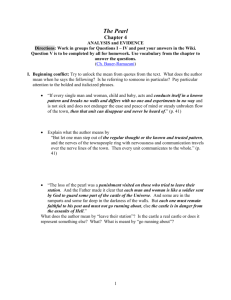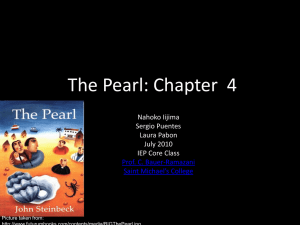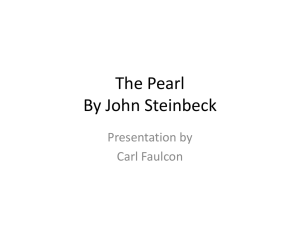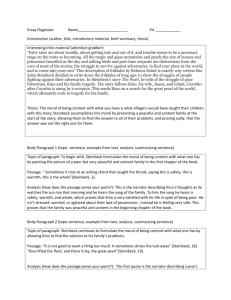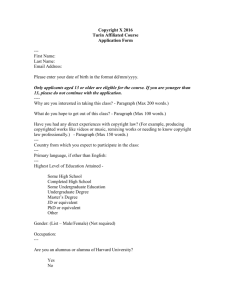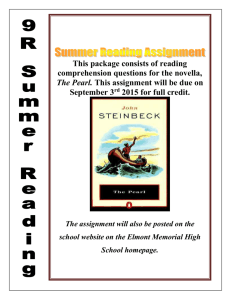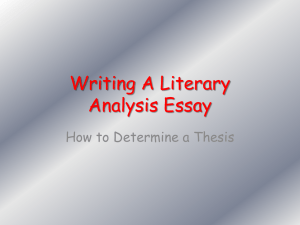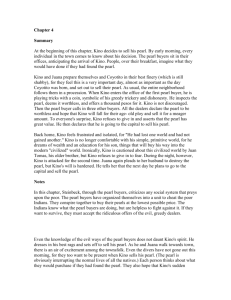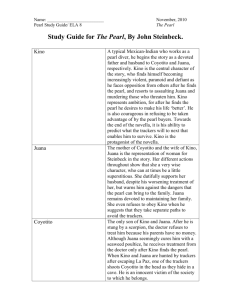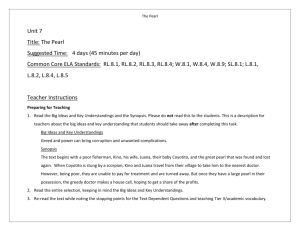The Pearl Study GuideANSWERS
advertisement
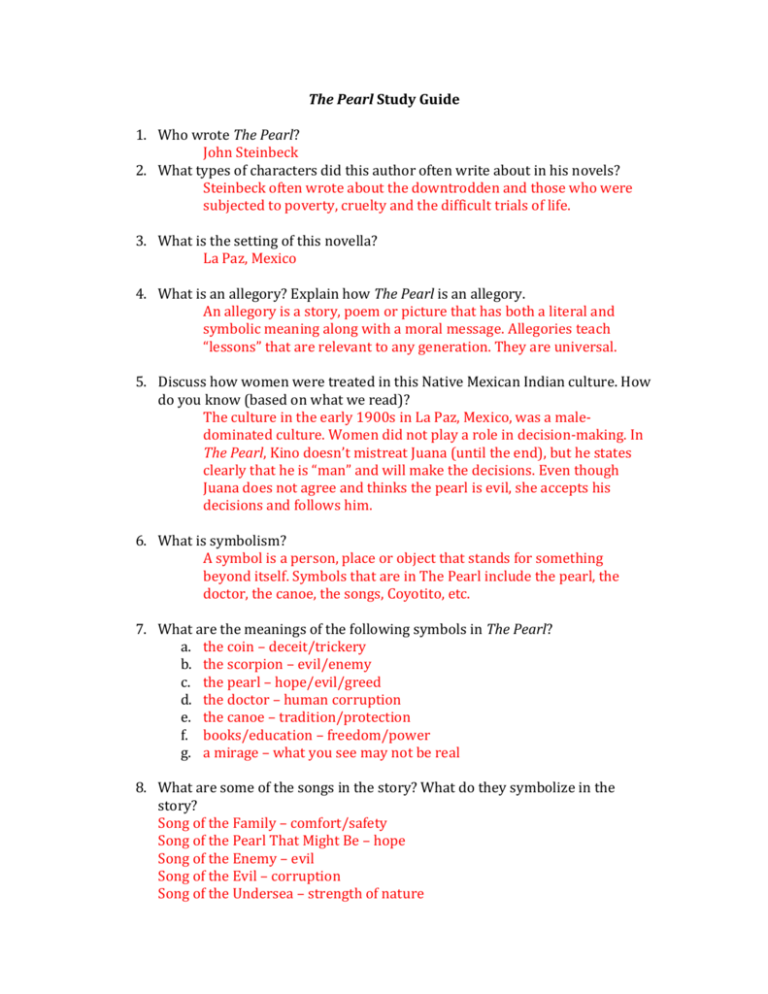
The Pearl Study Guide 1. Who wrote The Pearl? John Steinbeck 2. What types of characters did this author often write about in his novels? Steinbeck often wrote about the downtrodden and those who were subjected to poverty, cruelty and the difficult trials of life. 3. What is the setting of this novella? La Paz, Mexico 4. What is an allegory? Explain how The Pearl is an allegory. An allegory is a story, poem or picture that has both a literal and symbolic meaning along with a moral message. Allegories teach “lessons” that are relevant to any generation. They are universal. 5. Discuss how women were treated in this Native Mexican Indian culture. How do you know (based on what we read)? The culture in the early 1900s in La Paz, Mexico, was a maledominated culture. Women did not play a role in decision-making. In The Pearl, Kino doesn’t mistreat Juana (until the end), but he states clearly that he is “man” and will make the decisions. Even though Juana does not agree and thinks the pearl is evil, she accepts his decisions and follows him. 6. What is symbolism? A symbol is a person, place or object that stands for something beyond itself. Symbols that are in The Pearl include the pearl, the doctor, the canoe, the songs, Coyotito, etc. 7. What are the meanings of the following symbols in The Pearl? a. the coin – deceit/trickery b. the scorpion – evil/enemy c. the pearl – hope/evil/greed d. the doctor – human corruption e. the canoe – tradition/protection f. books/education – freedom/power g. a mirage – what you see may not be real 8. What are some of the songs in the story? What do they symbolize in the story? Song of the Family – comfort/safety Song of the Pearl That Might Be – hope Song of the Enemy – evil Song of the Evil – corruption Song of the Undersea – strength of nature 9. Understand the following literary elements as a part of the novel: a. Protagonist – usually the main character or the one most central to the action of the story; can have both good and bad qualities. Kino is the protagonist of this story. He is a dynamic character because he changes throughout the story. b. Foreshadowing – this is a hint about what is going to happen next; this could be in the form of a storm coming or someone providing a warning. In The Pearl, Juana and Juan Tomas both warn Kino about the danger of the pearl. This is foreshadowing when they do this. c. conflict (internal and external) – Internal conflict is a character’s struggle within himself (man vs. self). External conflict is a character’s struggle against an outside force (man vs. nature, man vs. man, man vs. society). Both kinds of conflict are found in The Pearl. d. exposition and resolution – Exposition is in the beginning of the story where the author reveals the characters, setting and sets up the conflict. Resolution is how the story wraps up. e. theme – Theme is the message the author is trying to send the reader. Theme is not one word. For instance, “greed” is a topic of The Pearl, but a theme is “greed destroys lives” is a theme. 10. How does the reader know Kino and Juana are poor? -They lived in a brush house. -They slept on a mat instead of a bed. -They wore torn and tattered clothing. -They could not go to school. -They could afford to pay to be married or baptized. 11. On p. 33, the author describes “life in the ocean.” What theme of the book is represented in this paragraph? “survival of the fittest”; “circle of life” 12. Why do Kino and the doctor hate each other so much? For more than 400 years, the doctor’s race (Europeans/Spanish) had subjugated (discriminated against) the Native Mexican Indians of that area. The Spanish/Catholics didn’t allow Kino’s race to be educated, own land or become wealthy in any way. The doctor viewed Kino’s race as animals. 13. How big was the pearl? It was described “as big as a seagull’s egg.” 14. What does Kino plan to do with the money he gets from the pearl? -buy new clothes -get married in the church -buy a harpoon -buy a rifle -send Coyotito to school 15. What do they do with the pearl at the end of the novella? They throw it back into the ocean. 16. When they do this, what does it symbolize? Man’s will power is stronger than greed. 17. Be able to identify the following types of figurative language: a. simile – comparing two unlike things using the word “like” or “as” b. metaphor – comparing two unlike things without using the word “like” or “as” c. hyperbole – an extreme exaggeration d. personification – giving human qualities to an inanimate (not human) object 18. Know the following characters: a. Kino – protagonist b. Juana – Kino’s wife c. the doctor - antagonist d. Coyotito – Juana and Kino’s baby e. the trackers – hunters of criminals (antagonist) f. the pearl buyers – scam artists (antagonist) g. Juan Tomas – Kino’s brother 19. Know the meaning of these vocabulary words used in context: avarice (p. 9) – extreme greed indigene (p. 9) – native countenanced (p. 42) – expected/tolerated contemptuous (p. 49) – showing scorn/disdain lethargy (p. 55) – extreme drowsiness bulwark (p. 14) – protection monotonously (p. 69) – without variety sentinel (p. 72) – guard/soldier lament (p. 64) – a mourning/sorrowful cry petulant (p. 80) – irritated Pre-AP You will have a two-part test. Along with a multiple choice test, you will write two essays. In order to be prepared to do this, review the following concepts/ideas from the novella. Kino as a dynamic character The Pearl as a parable/allegory The reaction of characters to the pearl and what these reactions say about human nature The importance of the songs in The Pearl
